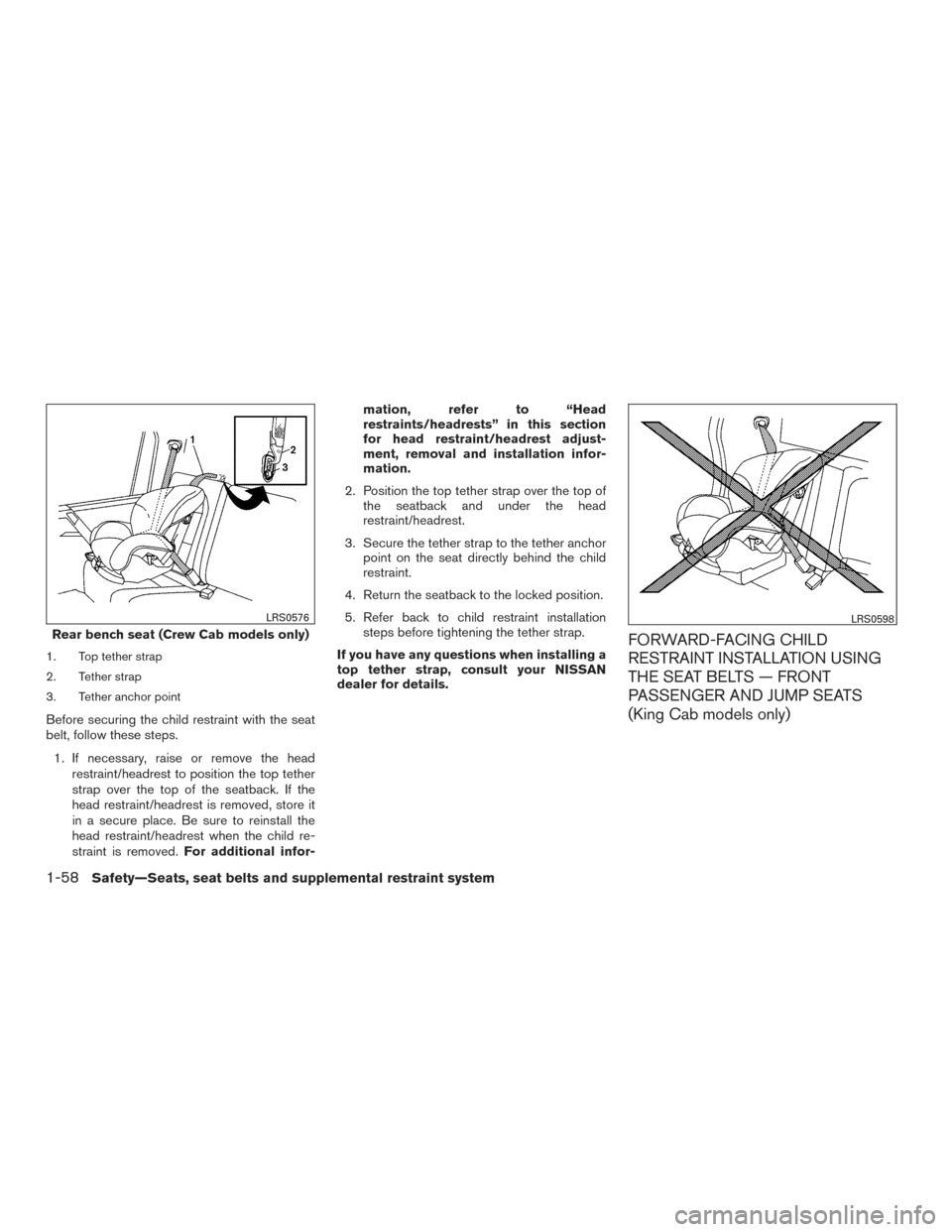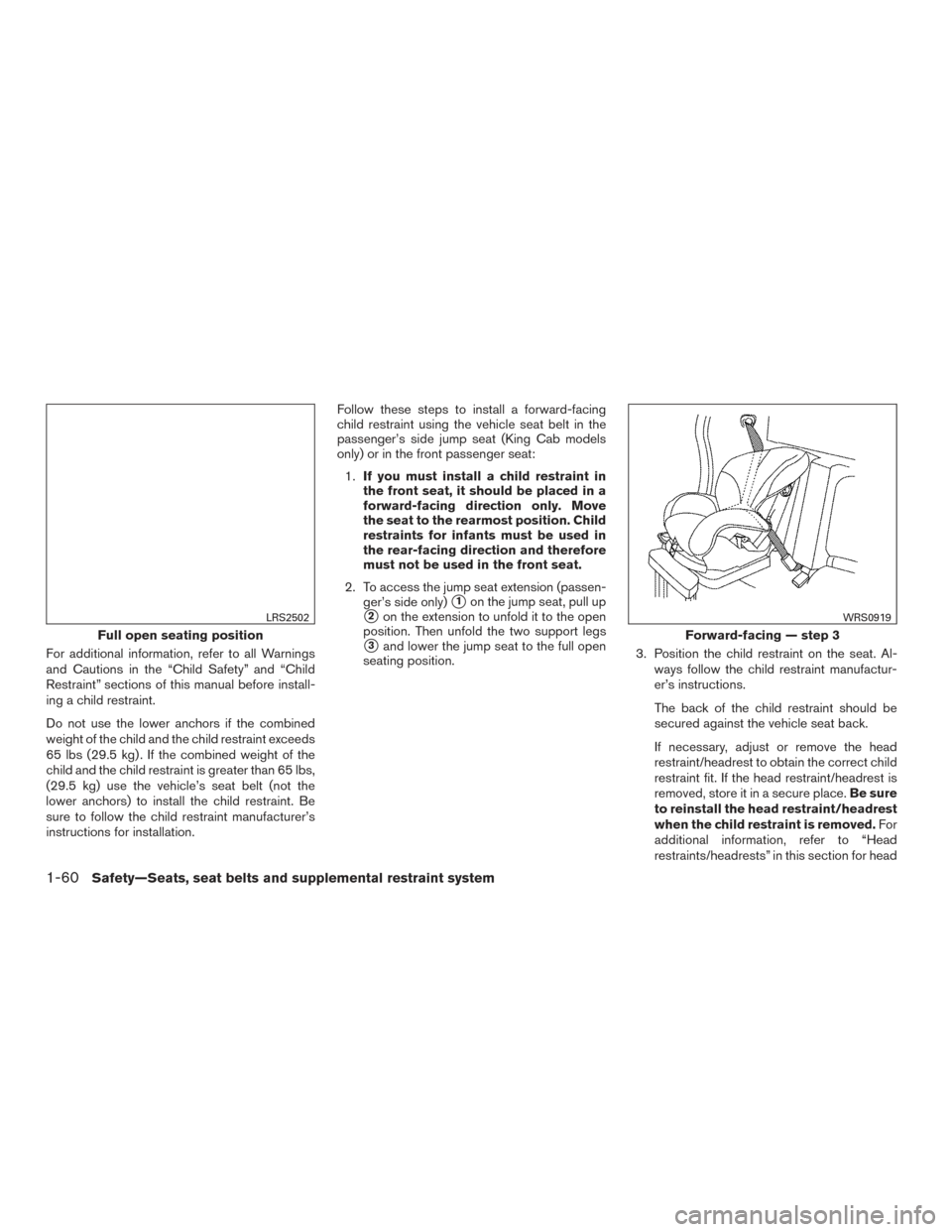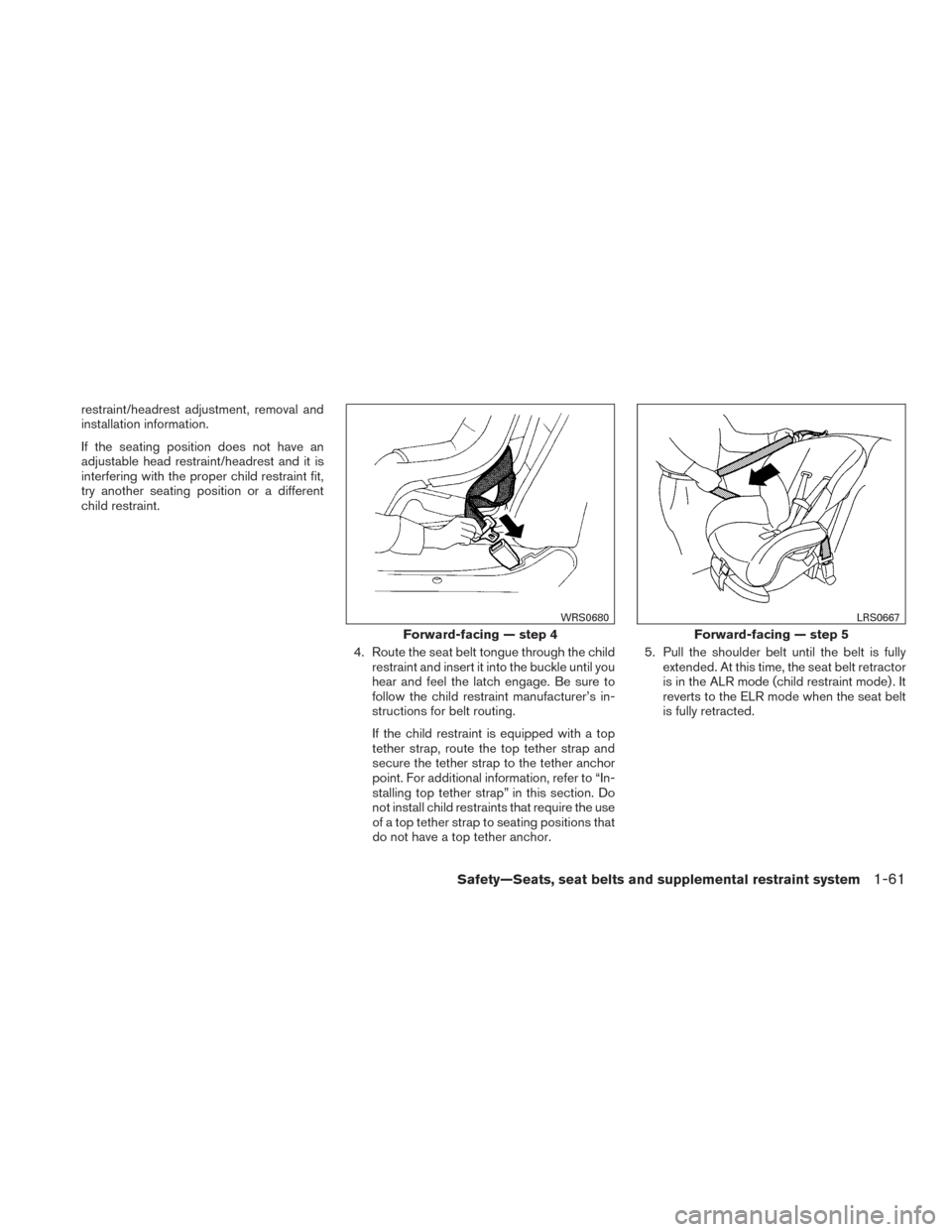Page 76 of 466

If the seating position does not have an
adjustable head restraint/headrest and it is
interfering with the proper child restraint fit,
try another seating position or a different
child restraint.3. Route the seat belt tongue through the childrestraint and insert it into the buckle until you
hear and feel the latch engage. Be sure to
follow the child restraint manufacturer’s in-
structions for belt routing.
If the child restraint is equipped with a top
tether strap, route the top tether strap and
secure the tether strap to the tether anchor
point (rear seat installation only) . For addi-
tional information, refer to “Installing top
tether strap” in this section. Do not install
child restraints that require the use of a top
tether strap in seating positions that do not
have a top tether anchor. 4. Pull the shoulder belt until the belt is fully
extended. At this time, the seat belt retractor
is in the ALR mode (child restraint mode) . It
reverts to ELR mode when the seat belt is
fully retracted.
Forward-facing – step 3
WRS0680
Forward-facing – step 4
LRS0667
Safety—Seats, seat belts and supplemental restraint system1-55
Page 77 of 466

5. Allow the seat belt to retract. Pull up on theshoulder belt to remove any slack in the belt. 6. Remove any additional slack from the seat
belt; press downward and rearward firmly in
the center of the child restraint with your
knee to compress the vehicle seat cushion
and seatback while pulling up on the seat
belt.
7. Tighten the tether strap according to the manufacturer’s instructions to remove any
slack. 8. After attaching the child restraint, test it be-
fore you place the child in it. Push it from side
to side while holding the child restraint near
the seat belt path. The child restraint should
not move more than 1 inch (25 mm) , from
side to side. Try to tug it forward and check
to see if the seat belt holds the restraint in
place. If the restraint is not secure, tighten
the seat belt as necessary, or put the re-
straint in another seat and test it again. You
may need to try a different child restraint. Not
all child restraints fit in all types of vehicles.
Forward-facing – step 5
LRS0668
Forward-facing – step 6
WRS0681
Forward-facing – step 8
WRS0698
1-56Safety—Seats, seat belts and supplemental restraint system
Page 78 of 466

9. Check to make sure the child restraint isproperly secured prior to each use. If the
seat belt is not locked, repeat steps 3
through 8.
10. If the child restraint is installed in the frontpassenger seat, place the ignition switch in
the ON position. The front passenger air bag
status light
should illuminate. If this
light is not illuminated, refer to �Front pas-
senger air bag and status light� in this sec-
tion. Move the child restraint to another
seating position. Have the system
checked by a NISSAN dealer.
After the child restraint is removed and the seat
belt is fully retracted, the ALR mode (child re-
straint mode) is canceled.
1. Pull strap
2. Anchor points
Installing top tether strap (rear bench
seat – Crew Cab models only)
To access the anchor points behind the rear
bench seat, tilt the rear seatback forward by
lifting up on the pull strap behind the seatback.
Forward-facing – step 10
WRS0475
Anchor point access
LRS0392
Safety—Seats, seat belts and supplemental restraint system1-57
Page 79 of 466

1. Top tether strap
2. Tether strap
3. Tether anchor point
Before securing the child restraint with the seat
belt, follow these steps.1. If necessary, raise or remove the head restraint/headrest to position the top tether
strap over the top of the seatback. If the
head restraint/headrest is removed, store it
in a secure place. Be sure to reinstall the
head restraint/headrest when the child re-
straint is removed. For additional infor- mation, refer to “Head
restraints/headrests” in this section
for head restraint/headrest adjust-
ment, removal and installation infor-
mation.
2. Position the top tether strap over the top of the seatback and under the head
restraint/headrest.
3. Secure the tether strap to the tether anchor point on the seat directly behind the child
restraint.
4. Return the seatback to the locked position.
5. Refer back to child restraint installation steps before tightening the tether strap.
If you have any questions when installing a
top tether strap, consult your NISSAN
dealer for details.
FORWARD-FACING CHILD
RESTRAINT INSTALLATION USING
THE SEAT BELTS — FRONT
PASSENGER AND JUMP SEATS
(King Cab models only)Rear bench seat (Crew Cab models only)
LRS0576LRS0598
1-58Safety—Seats, seat belts and supplemental restraint system
Page 80 of 466

WARNING
●The three-point seat belt with Auto-
matic Locking Retractor (ALR) must be
used when installing a child restraint.
Failure to use the ALR mode will result
in the child restraint not being properly
secured. The restraint could tip over or
be loose and cause injury to a child in a
sudden stop or collision. Also, it can
change the operation of the front pas-
senger air bag. For additional informa-
tion, refer to “Front passenger air bag
and status light” in this section.
● If a child restraint system is not in-
stalled properly, the child could be seri-
ously injured or killed in a sudden stop
or collision.
– Do not install a child restraint system on the passenger’s side jump seat
without unfolding the seat extender.
– For forward-facing child seats and boosters, DO NOT install if the child
restraint system base extends past
the forward edge of the driver’s side
seat cushion.
Forward-facing (front passenger seat) — step 1
WRS0699
Forward-facing (jump seat- King Cab) —step 2
LRS0559
Safety—Seats, seat belts and supplemental restraint system1-59
Page 81 of 466

For additional information, refer to all Warnings
and Cautions in the “Child Safety” and “Child
Restraint” sections of this manual before install-
ing a child restraint.
Do not use the lower anchors if the combined
weight of the child and the child restraint exceeds
65 lbs (29.5 kg) . If the combined weight of the
child and the child restraint is greater than 65 lbs,
(29.5 kg) use the vehicle’s seat belt (not the
lower anchors) to install the child restraint. Be
sure to follow the child restraint manufacturer’s
instructions for installation.Follow these steps to install a forward-facing
child restraint using the vehicle seat belt in the
passenger’s side jump seat (King Cab models
only) or in the front passenger seat:
1. If you must install a child restraint in
the front seat, it should be placed in a
forward-facing direction only. Move
the seat to the rearmost position. Child
restraints for infants must be used in
the rear-facing direction and therefore
must not be used in the front seat.
2. To access the jump seat extension (passen- ger’s side only)
�1on the jump seat, pull up
�2on the extension to unfold it to the open
position. Then unfold the two support legs
�3and lower the jump seat to the full open
seating position. 3. Position the child restraint on the seat. Al-
ways follow the child restraint manufactur-
er’s instructions.
The back of the child restraint should be
secured against the vehicle seat back.
If necessary, adjust or remove the head
restraint/headrest to obtain the correct child
restraint fit. If the head restraint/headrest is
removed, store it in a secure place. Be sure
to reinstall the head restraint/headrest
when the child restraint is removed. For
additional information, refer to “Head
restraints/headrests” in this section for headFull open seating position
LRS2502
Forward-facing — step 3
WRS0919
1-60Safety—Seats, seat belts and supplemental restraint system
Page 82 of 466

restraint/headrest adjustment, removal and
installation information.
If the seating position does not have an
adjustable head restraint/headrest and it is
interfering with the proper child restraint fit,
try another seating position or a different
child restraint.4. Route the seat belt tongue through the childrestraint and insert it into the buckle until you
hear and feel the latch engage. Be sure to
follow the child restraint manufacturer’s in-
structions for belt routing.
If the child restraint is equipped with a top
tether strap, route the top tether strap and
secure the tether strap to the tether anchor
point. For additional information, refer to “In-
stalling top tether strap” in this section. Do
not install child restraints that require the use
of a top tether strap to seating positions that
do not have a top tether anchor. 5. Pull the shoulder belt until the belt is fully
extended. At this time, the seat belt retractor
is in the ALR mode (child restraint mode) . It
reverts to the ELR mode when the seat belt
is fully retracted.
Forward-facing — step 4
WRS0680
Forward-facing — step 5
LRS0667
Safety—Seats, seat belts and supplemental restraint system1-61
Page 83 of 466

6. Allow the seat belt to retract. Pull up on theshoulder belt to remove any slack in the belt. 7. Remove any additional slack from the seat
belt; press downward and rearward firmly in
the center of the child restraint with your
knee to compress the vehicle seat cushion
and seatback while pulling up on the seat
belt.
8. Tighten the tether strap according to the manufacturer’s instructions to remove any
slack. 9. After attaching the child restraint, test it be-
fore you place the child in it. Push it from side
to side while holding the seat near the seat
belt path. The child restraint should not
move more than 1 inch (25 mm) from side to
side. Try to tug it forward and check to see if
the belt holds the restraint in place. If the
restraint is not secure, tighten the belt as
necessary, or put the restraint in another
seat and test it again. You may need to try a
different child restraint. Not all child re-
straints fit in all types of vehicles.
Forward-facing — step 6
LRS0668
Forward-facing – step 7
WRS0681
Forward-facing — step 9
WRS0698
1-62Safety—Seats, seat belts and supplemental restraint system